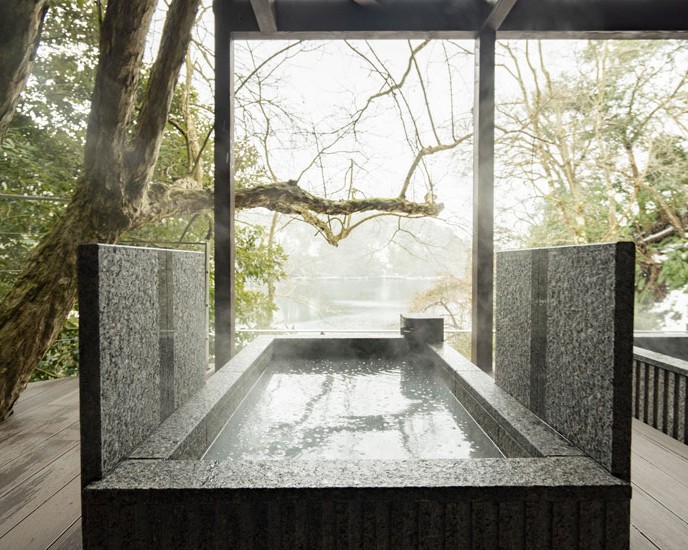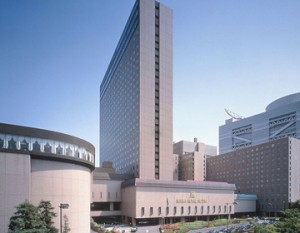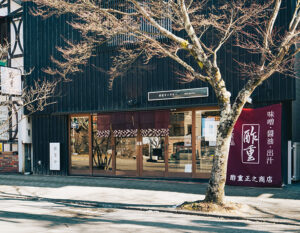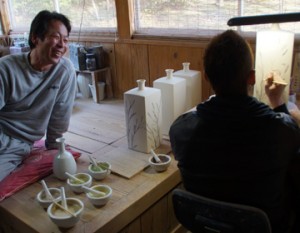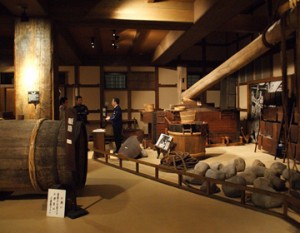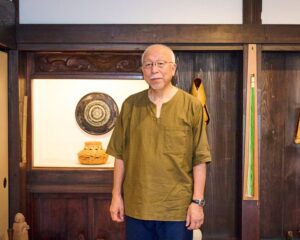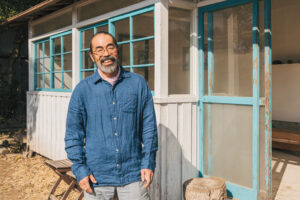Tsukumo Bay, consisting of large and small coves, is a scenic spot that has been selected as one of the 100 most scenic spots in Japan. On top of a hill overlooking the deep bay is the Noto Tsukumo Bay Hyakurasou, a ryokan with a history of more than 90 years since its establishment. The inn offers the luxury of spending a leisurely time with a spectacular view of the sea and greenery. The inn’s motto, “One Hundred Pleasures,” will add beauty to the impression of your trip.
Tsukumo Bay with its calm coves

Noto Town, Ishikawa Prefecture, is located near the tip of the Noto Peninsula. Following the port towns scattered along the coast to the east, you will find Kujukyuu Bay, one of Noto’s most scenic spots.
Tsukumo Bay is a rias coastline with an intricate coastline stretching 13 km in total length. The bay is up to 1,200 meters deep, and small boats float in the calm, lake-like bay. The scenery created by the numerous inlets is beautiful from season to season and never gets old.
Noto Tsukumo Bay Hyakuraso is an inn located on a hill overlooking the bay. Passing through the tasteful gate and up the mountain path, you will see the neat appearance of the inn.
Away from the hustle and bustle of daily life, spend the day in a Noto retreat.

Founded in 1934. It is a long-established ryokan that has been welcoming travelers for many years at the foot of the beautiful sea. In addition to its location overlooking Kujuku Bay, the inn’s high quality hospitality, including the creation of a space based on the concept of the extraordinary, and the comfortable service that is both intimate and intimate, have attracted many repeat guests.
The cave bath was dug by hand by a stonemason over a period of three years.

The inn’s specialty is a cave bath located 30 meters underground. From the front desk, take the elevator down to the second basement level, and you will find a cave that was dug by a stonemason about 50 years ago over a period of three years.
In the past, this area was a production area of “ogiishi,” a type of stone used for kamados and sunken hearths, and many stonemasons were active in this area until the mid-Showa period (1926-1989). When the mining of ogiishi came to an end, a craftsman known as “the last stonemason” dug this cave at the request of the inn. The pickaxe marks left on the rock surface are also a part of Noto’s history.

With the light illuminating our feet, we finally entered the cave baths. Surrounded by rocks, the bathtub is filled to the brim with deep seawater pumped up from a depth of 320 meters off the coast of Tsukumo Bay. Deep seawater that has been lying dormant in the deep sea feels good against the skin, and a relaxing soak will immediately relax the body and mind.
The cave baths were renovated in June 2024, adding an open-air bath with a view of Tsukumo Bay and a cave sauna with fantastic indirect lighting. Many visitors come for this extraordinary space.
Rooms with a serene seascape all to yourself
There are a total of 26 guest rooms, ranging from standard rooms to upper suites. Each room has its own unique style, such as those with an open-air bath or terrace, and the carefully selected furnishings and lighting create a high-quality relaxing atmosphere. Above all, the view of Tsukumo Bay from the guest rooms is the best reward for forgetting everyday life. The quiet bay changes its appearance from morning to evening, allowing you to enjoy the luxury of doing nothing at all to your heart’s content.
There are many places to spend your time in the hotel, including a game lounge where you can enjoy darts and billiards, five private baths, and a premium lounge for the exclusive use of suites. The hotel has been renovated little by little every year so that each guest can enjoy “a hundred pleasures”.
Damaged by the Noto Peninsula Earthquake, the hotel was temporarily closed.

On New Year’s Day, January 1, 2024, when most guests had checked in and were relaxing, the Noto Peninsula earthquake struck. The staff split up to guide guests to a safe place, but the road leading to the inn became impassable due to cracks in the ground, and the guests were isolated. They spent an anxious night. The inn staff worked hard to restore the road using blocks and other materials, and managed to see all guests off the next day.
Honomi Kumagaya, the general manager of the inn, recalls her thoughts at the time: “Our first priority was the safety of our guests. The safety of our guests was our top priority. When we received a call from a guest who had returned safely, we were deeply relieved.

The most severe damage to the inn was to its seaside facilities. The fishing pier, which had been popular for its dinner service of serving fish caught at the inn, was washed away by the tsunami. A separate dining room, which had also been built to jut out into the ocean, was washed away by the waves, along with its foundation. Although the building on the hill was not severely damaged, many facilities and equipment were destroyed, and the water supply was completely cut off. Mr. Kumagai decided that it would be difficult to operate for the time being.
What gave strength to the staff working on restoration
The water supply was restored the month after the earthquake. However, the water supply was still cut off in the neighborhood, and many people were living in evacuation centers. While repairing guest rooms and carrying out other restoration work in preparation for the resumption of business, the staff voiced their desire to do what they could for the community, and an event was planned to provide meals and baths to the local residents.
The smiles on the faces of those who had bathed and relaxed, and the energy in the inn for a brief moment, gave the staff a great boost.
The inn received many calls of support from all over the country, including from repeat guests. Kumagai recalls with a smile, “I realized once again that we are supported by the people of the community and our guests who love Hyakurasou.
The restaurant reopened on April 19, about three and a half months after the earthquake. Although the number of customers was not expected to return, the decision was made in the belief that attracting as many people as possible to Noto would help in the recovery effort.
The torrential rain disaster brought back the number of customers that had begun to return.
When the hotel first reopened, there was a mood of self-restraint in entering the disaster area, and the number of guests was low. However, the number of repeat guests who had been waiting for the reopening of the hotel and those who stayed to support the Noto community gradually increased, and the hotel was finally busy again during the summer vacation, the high season.
However, in September of that year, disaster struck Noto again. The Noto Peninsula torrential rainfall was the second serious disaster following the Noto Peninsula earthquake. Although there was no direct damage to the inn, which is located on high ground, reservations were cancelled one after another, and the number of visitors once again dropped off. The torrential rain disaster came just as reconstruction efforts were underway. Farmers with whom the inn does business were also severely damaged, and the inn was left with a heavy burden. It was heartbreaking to think of the damage to such a large area of Noto,” Kumagai said. Even so, the staff did their best to entertain guests and were encouraged by the outpouring of support.
One year after the earthquake and three months after the torrential rains, the rooms were finally fully booked at the end and beginning of the year. Many guests said, “I came here to support Noto’s recovery,” and Mr. Kumagai was reminded of the mission of an inn rooted in the community. If we can be of even the slightest help to Noto’s recovery, I am glad that we have worked so hard over the past year to build up our business,” he said.
Aiming to be an inn that works together with Noto’s producers

One of the specialties of “Noto Tsukumo Bay Hyakuraso” is its cuisine, which incorporates the rich produce of Noto. However, many producers were affected by the earthquake, and the market and distribution functions that handle the foodstuffs were paralyzed. Producers with whom they do business on a regular basis found themselves in a difficult situation: they could not go fishing, they could not sell what they produced, and they could not ship their products.

Although he could have ordered unavailable ingredients from outside of Noto, Executive Chef Daisuke Shimada decided to “use ingredients from Noto as much as possible. He visited producers to purchase ingredients, and when he heard that someone was looking for a place to ship, he asked for an introduction. By firmly connecting the producers and the inn’s business network in this way, Mr. Shimada says, “I want to protect Noto’s producers and its bountiful bounty.

On this day, the dish featured wild yellowtail purchased at the port of Ushitsu, Noto Town, and Kanou crab freshly landed at the port of Takojima, Suzushi City. Because the ingredients are so good, we don’t add anything extra to them. I want people to fully enjoy the charm of Noto’s ingredients,” smiles Mr. Shimada.
Until the day we can truly call it “reconstruction

About a year has passed since the reopening of business, but the fishing pier and restaurant lost in the tsunami remain untouched. Efforts to restore the facilities are still ongoing.
On the other hand, Mr. Kumagai believes that “complete restoration of facilities is not the goal. While Noto as a whole is gradually making progress in rebuilding its infrastructure and livelihood, the scars are still large. The real goal, Kumagai says, is for visitors to the inn “to be able to tour Noto, which has regained its vitality, and experience new attractions and enjoyment.
When touring Noto, I often hear people say, “I want people to see Noto as it is now,” or “I want many people to visit Noto. The more people who visit Noto, the stronger the recovery effort will be. Noto Tsukumo Bay Hyakurasou” will serve as a starting point for such trips, and will continue to move forward positively toward reconstruction in the true sense of the word.



